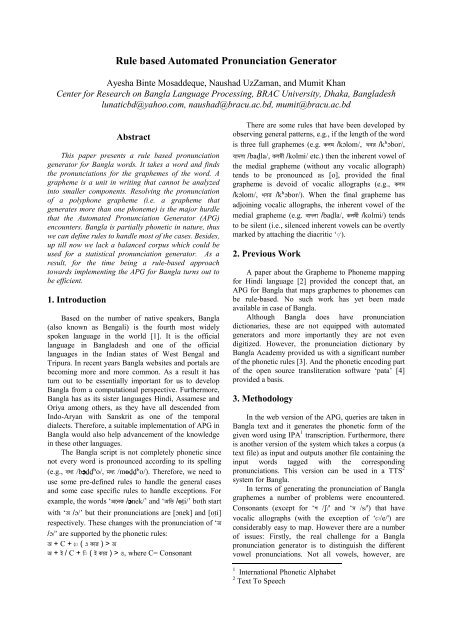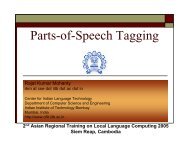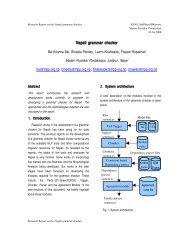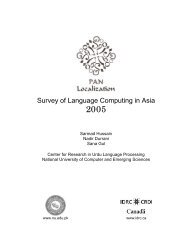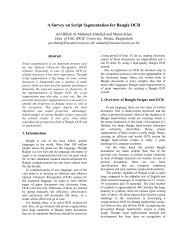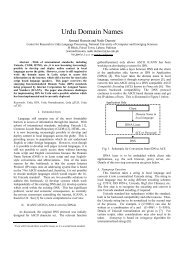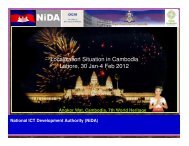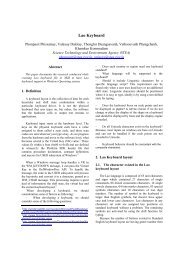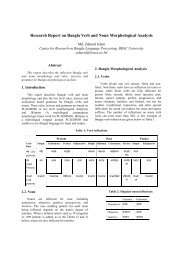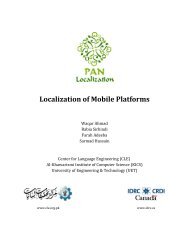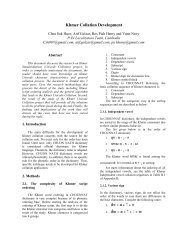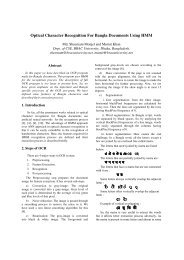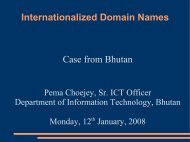Rule based Automated Pronunciation Generator - PAN Localization
Rule based Automated Pronunciation Generator - PAN Localization
Rule based Automated Pronunciation Generator - PAN Localization
Create successful ePaper yourself
Turn your PDF publications into a flip-book with our unique Google optimized e-Paper software.
<strong>Rule</strong> <strong>based</strong> <strong>Automated</strong> <strong>Pronunciation</strong> <strong>Generator</strong><br />
Ayesha Binte Mosaddeque, Naushad UzZaman, and Mumit Khan<br />
Center for Research on Bangla Language Processing, BRAC University, Dhaka, Bangladesh<br />
lunaticbd@yahoo.com, naushad@bracu.ac.bd, mumit@bracu.ac.bd<br />
Abstract<br />
This paper presents a rule <strong>based</strong> pronunciation<br />
generator for Bangla words. It takes a word and finds<br />
the pronunciations for the graphemes of the word. A<br />
grapheme is a unit in writing that cannot be analyzed<br />
into smaller components. Resolving the pronunciation<br />
of a polyphone grapheme (i.e. a grapheme that<br />
generates more than one phoneme) is the major hurdle<br />
that the <strong>Automated</strong> <strong>Pronunciation</strong> <strong>Generator</strong> (APG)<br />
encounters. Bangla is partially phonetic in nature, thus<br />
we can define rules to handle most of the cases. Besides,<br />
up till now we lack a balanced corpus which could be<br />
used for a statistical pronunciation generator. As a<br />
result, for the time being a rule-<strong>based</strong> approach<br />
towards implementing the APG for Bangla turns out to<br />
be efficient.<br />
1. Introduction<br />
Based on the number of native speakers, Bangla<br />
(also known as Bengali) is the fourth most widely<br />
spoken language in the world [1]. It is the official<br />
language in Bangladesh and one of the official<br />
languages in the Indian states of West Bengal and<br />
Tripura. In recent years Bangla websites and portals are<br />
becoming more and more common. As a result it has<br />
turn out to be essentially important for us to develop<br />
Bangla from a computational perspective. Furthermore,<br />
Bangla has as its sister languages Hindi, Assamese and<br />
Oriya among others, as they have all descended from<br />
Indo-Aryan with Sanskrit as one of the temporal<br />
dialects. Therefore, a suitable implementation of APG in<br />
Bangla would also help advancement of the knowledge<br />
in these other languages.<br />
The Bangla script is not completely phonetic since<br />
not every word is pronounced according to its spelling<br />
(e.g., /bɔd͍d͍ʰo/, /mod͍d͍ʰo/). Therefore, we need to<br />
use some pre-defined rules to handle the general cases<br />
and some case specific rules to handle exceptions. For<br />
example, the words ‘aк /ɔnek/’ and ‘a /ot̼i/’ both start<br />
with ‘a /ɔ/’ but their pronunciations are [ɔnek] and [ot̼i]<br />
respectively. These changes with the pronunciation of ‘a<br />
/ɔ/’ are supported by the phonetic rules:<br />
a + C + ◌ ( e к ) > a<br />
a + i / C + ◌ ( i к ) > o, where C= Consonant<br />
There are some rules that have been developed by<br />
observing general patterns, e.g., if the length of the word<br />
is three full graphemes (e.g. к /kɔlom/, х /kʰɔbor/,<br />
/bad͍la/, к /kolmi/ etc.) then the inherent vowel of<br />
the medial grapheme (without any vocalic allograph)<br />
tends to be pronounced as [o], provided the final<br />
grapheme is devoid of vocalic allographs (e.g., к<br />
/kɔlom/, х /kʰɔbor/). When the final grapheme has<br />
adjoining vocalic allographs, the inherent vowel of the<br />
medial grapheme (e.g. /bad͍la/, к /kolmi/) tends<br />
to be silent (i.e., silenced inherent vowels can be overtly<br />
marked by attaching the diacritic ‘◌ ').<br />
2. Previous Work<br />
A paper about the Grapheme to Phoneme mapping<br />
for Hindi language [2] provided the concept that, an<br />
APG for Bangla that maps graphemes to phonemes can<br />
be rule-<strong>based</strong>. No such work has yet been made<br />
available in case of Bangla.<br />
Although Bangla does have pronunciation<br />
dictionaries, these are not equipped with automated<br />
generators and more importantly they are not even<br />
digitized. However, the pronunciation dictionary by<br />
Bangla Academy provided us with a significant number<br />
of the phonetic rules [3]. And the phonetic encoding part<br />
of the open source transliteration software ‘pata’ [4]<br />
provided a basis.<br />
3. Methodology<br />
In the web version of the APG, queries are taken in<br />
Bangla text and it generates the phonetic form of the<br />
given word using IPA 1 transcription. Furthermore, there<br />
is another version of the system which takes a corpus (a<br />
text file) as input and outputs another file containing the<br />
input words tagged with the corresponding<br />
pronunciations. This version can be used in a TTS 2<br />
system for Bangla.<br />
In terms of generating the pronunciation of Bangla<br />
graphemes a number of problems were encountered.<br />
Consonants (except for ‘ш /ʃ/' and ‘ /s/') that have<br />
vocalic allographs (with the exception of ‘◌/e/') are<br />
considerably easy to map. However there are a number<br />
of issues: Firstly, the real challenge for a Bangla<br />
pronunciation generator is to distinguish the different<br />
vowel pronunciations. Not all vowels, however, are<br />
1 International Phonetic Alphabet<br />
2 Text To Speech
Working Papers 2004-2007<br />
polyphonic. ‘a /ɔ/’ and ‘e /e/' have polyphones (‘a /ɔ/’'<br />
can be pronounced as [o] or [ɔ], ‘e /e/' can be<br />
pronounced as [e] or [æ], depending on the context) and<br />
dealing with their polyphonic behavior is the key<br />
problem. Secondly, the consonants that do not have any<br />
vocalic allograph have the same trouble as the<br />
pronunciation of the inherent vowel may vary. Thirdly,<br />
the two consonants ‘ш /ʃ/’ and ‘ /s/’ also show<br />
polyphonic behavior. And finally, the ‘consonantal<br />
allographs’(◌ /ɟ/,◌ /r/,◌ /b/,◌ /m/), and the grapheme<br />
‘ /j/' complicate the pronunciation system further.<br />
Hypothetically, all the pronunciations are supposed<br />
to be resolved by the existing phonetic rules. But as a<br />
matter of fact they do not; some of them require<br />
heuristic assumptions. The phonetic rules that have been<br />
used are described in Table 1. Some of the rules are<br />
described below:<br />
• If a word starts with ‘a /ɔ/’ followed by ‘k’ or ‘j<br />
/ŋ/’ then the ‘a /ɔ/’ is pronounced as [o]. For<br />
example, ‘akш /okkʱaɳsho/’, ‘j /joggo/’.<br />
• If the first grapheme of a word is devoid of any<br />
vocalic allographs and a ‘◌ /r/’ or ‘◌ /ɟ/’is attached<br />
to it then the implicit ‘a /ɔ/’ (associated to the first<br />
grapheme) is pronounced as [o]. For example, ‘k<br />
/krom/’, ‘a /oddo/’. There is one exception to this<br />
rule that is when there is a ‘ /j/’ after the ‘◌ /r/’<br />
then the implicit ‘a /ɔ/’ (associated to the first<br />
grapheme) is pronounced as [ɔ]. For example, ‘k<br />
/krɔj/’.<br />
• If the first grapheme of a word is devoid of any<br />
vocalic allographs and the consonant following it is<br />
accompanied with a ‘◌ /ri/’ ( к) then the implicit<br />
‘a /ɔ/’ (associated to the first grapheme) is<br />
pronounced as [o]. For example, ‘ /mosrin/’.<br />
• If a word starts with ‘a /ɔ/’ followed by ‘i /i/’ or ‘u<br />
/u/’ or their corresponding vocalic allographs (◌<br />
/i/,◌ /u/) then the ‘a /ɔ/’ is pronounced as [o]. For<br />
example, ‘a /obʱidʱan/’.<br />
• If a word starts with ‘◌/e/’ associated with a<br />
consonant followed by a ‘◌ /ɳ/’ or ‘ /ɳ/’ and if<br />
there is no ‘◌ /i/’, ‘◌ /i/’, ‘◌ /u/’ or ‘◌ /u/’ then the<br />
‘◌/e’ is pronounced as [ӕ]. But if there is a ‘◌/i’, ‘◌<br />
/i/’,‘◌ /u/’ or ‘◌ /u/’ then the ‘◌/e/’ is pronounced as<br />
[e]. For example, ‘ /bӕɳ/’, but ‘ /beɳi/’.<br />
• If the consonantal allograph ‘◌ /b/’ is associated<br />
with the first grapheme of a word then the ‘◌ /b/’<br />
is silent. For example, ‘ð /dʱoni/’.<br />
• If the consonantal allograph ‘◌ /b/’ is associated<br />
with a grapheme in the middle or at the end of a<br />
word then that grapheme’s pronunciation is<br />
doubled. For example, ‘ /bisʱsʱo/’.<br />
• If the consonantal allograph ‘◌ /m/’ is associated<br />
with a grapheme in the middle or at the end of a<br />
word then that grapheme’s pronunciation is doubled<br />
and the last grapheme is pronounced in a slightly<br />
nosal tone. For example, ‘ /rosʱsʱi/’. But there<br />
are some graphemes (‘ /g/’, ’ /ɳ/’, ’a /t/’, ’ /n/’,<br />
’ /n/’, ’ /m/’, ’ /l/’) when associated with ‘◌ /m/’<br />
keep the pronunciation of ‘ /m/’ unchanged. For<br />
example, ‘g /bagmi/’, ‘n /jɔnmo/’.<br />
• The consonantal allograph ‘◌ /ɟ/’, when associated<br />
with the middle or end grapheme of a word, is not<br />
pronounced. For example, ‘n /shond̼ʱa/’.<br />
• If there is ‘ /j/’ at the end of the word and no<br />
vowel is associated with .and the previous letter<br />
contains a ‘◌ /i/’ or ‘◌ /i/’, the ‘ /j/’ is pronounced<br />
as ‘ /jo/’. For example, ‘ /ɟatijo/’.<br />
Table 1 contains the phonetic rules. Apart from these<br />
some heuristic rules are used in APG. Few such rules<br />
are shown in Table 2. They were formulated while<br />
implementing the system. Most of them serve the<br />
purpose of generating pronunciation for some specific<br />
word pattern.<br />
ote: C = Consonant. C◌<br />
C = Conjunct Consonant<br />
Table 1: <strong>Pronunciation</strong> <strong>Rule</strong>s<br />
Letter/IPA/ <strong>Pronunciation</strong> <strong>Rule</strong>s Example<br />
a / ɔ /<br />
a+k+C (k conjuncted with a consonant) k > k х<br />
a / ɔ /<br />
Implicit a+◌ ( ) + <br />
k<br />
a+C◌ C+ ◌ ( )<br />
an > an<br />
125
Bengali<br />
o / o /<br />
a at the begining<br />
a+i / C+◌ (i к)<br />
a > o<br />
a+ u / C + ◌ (u к) ak > ok<br />
a+ > <br />
a+C+◌ ( )<br />
a > od<br />
a+ k k > кх<br />
a+ j j > g<br />
a+ C+◌ ( к)<br />
> <br />
a / ɔ / o / o /<br />
<strong>Pronunciation</strong><br />
<strong>Rule</strong>s<br />
Example<br />
Implicit a+◌ ( ) k > k, d ><br />
d<br />
a + r ()+◌ ( )<br />
n ( prevoius<br />
the spelling has been changed to a+r ()<br />
but first ‘a’ is pronuounced ‘o’<br />
spelling n) ><br />
n<br />
a at middle (implicit with consonents)<br />
If a word has 3 or more letters, bfeore the<br />
‘a’ at middle there is ‘a’,’å’,’e’ and ‘o’,<br />
then the mid –‘a’ is pronounced as ‘o’.<br />
a at end<br />
Words that end with ‘-å’, ‘-’, ‘-i’ are<br />
pronounced as o at the end<br />
if there is ‘’ after ‘i’ or ‘◌’ then it is<br />
pronounced as ‘o’<br />
Words that end with ‘-’,’-’ are<br />
pronounced as ‘o’ at the end<br />
if there are conjuncted consonants at the<br />
end of the word then it is pronounced as<br />
‘o’.<br />
if there is ‘’ or ‘’ at the end of the word<br />
then it is pronounced as ’o’<br />
if there is ‘’ after ‘a’ or ‘å’ then it is<br />
pronounced as ‘’ followed by ‘◌ ’ (n)<br />
к > к, ><br />
, > ,<br />
ш > шшn ,<br />
к > к, х<br />
> х, > ,<br />
> <br />
s > ш<br />
aк > oк,<br />
aк > oк<br />
шk > шk<br />
к > к , ><br />
/ rho<br />
> <br />
126<br />
å / a/<br />
◌ e / e/<br />
å / a/ å or C + ◌ å, <br />
e / e /<br />
/ ӕ/ j/ ◌ + å j > n , <br />
><br />
e At the begining<br />
◌ /e + i /◌ / и / ◌ /u/ ◌ / / ◌ / e / ◌ / o/<br />
◌ / / / / ш / <br />
eк > eк, х ><br />
х, х, ekш, х,<br />
, , ш, к<br />
◌ /e + ◌ / / + ◌ / i / ◌ / u > , >
Working Papers 2004-2007<br />
Monosyllabic pronouns<br />
к, e, <br />
/ ӕ/ e / ◌+ (◌ / / )+ ◌ / not ( ◌/ i /◌ / u) > , <br />
> <br />
◌ / ŋ/ a / Ong/ - <br />
/ ɲ/ / n/<br />
- > n <br />
+ <br />
◌ + <br />
a > an<br />
j > n<br />
/ b as <br />
Changed<br />
At the begining<br />
C+ ◌ is not pronounced<br />
sк > шк<br />
Letter/IPA/<br />
/m as <br />
<strong>Pronunciation</strong><br />
Unchanged<br />
Changed<br />
<strong>Rule</strong>s<br />
At middle or end C+ ◌ is doubled<br />
At the begining, middle or end<br />
C◌ C + ◌ is not pronounced<br />
Words that start with ‘ud ‘and have ‘’ as<br />
‘’, retain the pronunciation of ‘’<br />
+◌ or + ◌ , retain the pronunciation of<br />
‘’<br />
At the begining C+ ◌ is not pronounced,<br />
but C is pronounced with a slight nasal<br />
tone<br />
Example<br />
> ш<br />
ujj > uj<br />
ud > ud <br />
b > b,<br />
m > m<br />
s > <br />
At middle or end C+ ◌ is doubled and C<br />
is pronounced with a slight nasal tone<br />
d > d<br />
Unchaned<br />
At the begining, middle or end<br />
C◌ C + ◌ is not pronounced and the last<br />
C is pronounced with a slight nasal tone<br />
At middle or end<br />
/ / a / / / / + ◌ , retain the<br />
pronunciation of ‘’<br />
kß > шk х<br />
g > g , n ><br />
n <br />
/ ɟ as <br />
/ ӕ/ At the begining C + ◌ or C + ◌ +◌ > <br />
e / e/ At the begining C + ◌ + ◌ k > k <br />
Unpronounced At middle or end with conjuncts C◌ C+ ◌ > r <br />
Doubled At middle or end C + ◌ , C is doubled > n <br />
/ r as / r/<br />
At the begning C + ◌ , if C does not have<br />
any vowel associated with it then the it is<br />
pronounced as ‘o’, and C is not doubled<br />
At middle or end C + ◌ , C is doubled<br />
pкш > pк<br />
d> d d<br />
At middle or end with conjuncts<br />
C + ◌ , C is not doubled<br />
кnd > кn d<br />
/ l as / l/ At the begning C + ◌ , C is not doubled p > pn<br />
127
Bengali<br />
ш / ʃ/<br />
At middle or end<br />
C + ◌ , C is doubled<br />
åt > åts<br />
/ s / when conjuncted with / / / p > ps<br />
ш / ʃ/ when not conjuncted ш > шt<br />
/ s/ / s/<br />
when conjuncted with / / / <br />
s > sn<br />
For foreign words<br />
> s<br />
ш / ʃ/ when not conjuncted > шn<br />
/ ʃ/ ш / ʃ/ Always pronounced as ш / ʃ ß > шш<br />
<br />
h / h For exclamatory words å > åh<br />
o / o<br />
At the end C+ ◌ , C is pronounced as ‘o’<br />
if no vowel associated with it<br />
> <br />
doubled At middle C+ ◌ , C is doubled ш > шшß<br />
Table 2: Heuristic <strong>Rule</strong>s<br />
Letter/IPA/ <strong>Rule</strong>s Example<br />
/ ʃ / Always pronounced as ш / ß > шш<br />
/ ɟ / If there is ‘‘before ‘’ and no vowel is<br />
associated with ‘’, then ‘’ is pronounced<br />
as ‘j’<br />
> þ<br />
/ j /<br />
If ‘’ is followed by ‘’ or ‘’, and no<br />
vowel is associated with ‘’, and then if<br />
there is any ‘◌’ or ‘◌’, then ‘’ is<br />
pronounced as ‘’, else it is pronounced as<br />
‘’.<br />
If there is ‘’ at the end of the word and no<br />
vowel is associated with ‘’ and the<br />
previous letter contains a ‘ ◌ ‘ or ‘◌ ’,<br />
the ‘’ is pronounced as ‘’.<br />
> <br />
> l<br />
> <br />
128
Working Papers 2004-2007<br />
4. Implementation<br />
APG has been implemented in Java (jdk1.5.0_03).<br />
The web version of APG contains a Java applet that<br />
can be used with any web client that supports applets.<br />
The other version of APG is also implemented in Java.<br />
Both<br />
the versions generate the pronunciation on the fly; to<br />
be precise no look up file has been associated. Figure<br />
1 illustrates the user interface of the web version and<br />
Figure 2 illustrates the output format of the other<br />
version.<br />
Table 3: Evaluation of accuracy<br />
Number of words Accuracy Rate (%)<br />
736 97.01<br />
8399 81.95<br />
The reason of the high accuracy rate of the 736-<br />
word corpus is that, the patterns of the words of this<br />
corpus were used for generating the heuristic rules.<br />
The words in the other corpus were chosen randomly.<br />
The error analysis was done manually by matching the<br />
output with the Bangla Academy pronunciation<br />
dictionary.<br />
6. Conclusion<br />
Figure 1 : The web interface of APG. The input<br />
word is ‘aш<br />
aш’ and the correponding output is<br />
‘Ǥȓ<br />
Ǥȓeȓ’.<br />
The proposed APG for Bangla has been designed<br />
to generate the pronunciation of a given Bangla word<br />
in a rule <strong>based</strong> approach. The actual challenge in<br />
implementing the APG was to deal with the polyphone<br />
graphemes. Due to the lack of a balanced corpus, we<br />
had to select the rule-<strong>based</strong> approach for developing<br />
the APG. However, a possible future upgrade is<br />
implementing a hybrid approach comprising both a<br />
rule <strong>based</strong> and a statistical grapheme-to-phoneme<br />
converter. Also, including a look up file will increase<br />
the efficiency of the current version of APG<br />
immensely. This will allow the system to access a<br />
database for look up. That way, any given word will<br />
first be looked for in the database (where the correct<br />
pronunciation will be stored), if the word is there then<br />
the corresponding pronunciation goes to the output, or<br />
else, the pronunciation is deduced using the rules.<br />
7. Acknowledgement<br />
Figure 2 : the output file generated by the plug-in<br />
version of APG.<br />
5. Result<br />
The performance of the rule-<strong>based</strong> APG proposed<br />
by this paper is challenged by the partial phonetic<br />
nature of Bangla script. The accuracy rate of the<br />
proposed APG for Bangla was evaluated on two<br />
different corpora that were collected from a Bangla<br />
newspaper. The accuracy rates observed are shown in<br />
Table 3.<br />
This work has been supported in part by the <strong>PAN</strong><br />
<strong>Localization</strong> Project (www.panl10n.net) grant from the<br />
International Development Research Center, Ottawa,<br />
Canada, administrated through Center for Research in<br />
Urdu Language Processing, National University of<br />
Computer and Emerging Sciences, Pakistan.<br />
8. References<br />
[1] The Summer Institute for Linguistics (SIL)<br />
Ethnologue Survey, 1999.<br />
[2] M. Choudhury, “<strong>Rule</strong>-<strong>based</strong> Grapheme to<br />
Phoneme Mapping for Hindi Speech Synthesis”,<br />
Proceedings of the International Conference On<br />
Knowledge-Based Computer Systems, Vikas<br />
Publishing House, Navi Mumbai, India, 2002, pp. 343<br />
129
Bengali<br />
– 353. Available online at:<br />
http://www.mla.iitkgp.ernet.in/papers/G2PHindi.pdf<br />
[3] Bangla Uchcharon Obhidhan, Bangla Academy,<br />
Dhaka, Bangladesh.<br />
[4] Transaliteration Software - Pata, developed by<br />
Naushad UzZaman, CRBLP, BRAC University.<br />
Available online at:<br />
http://www.naushadzaman.com/pata.html<br />
130


